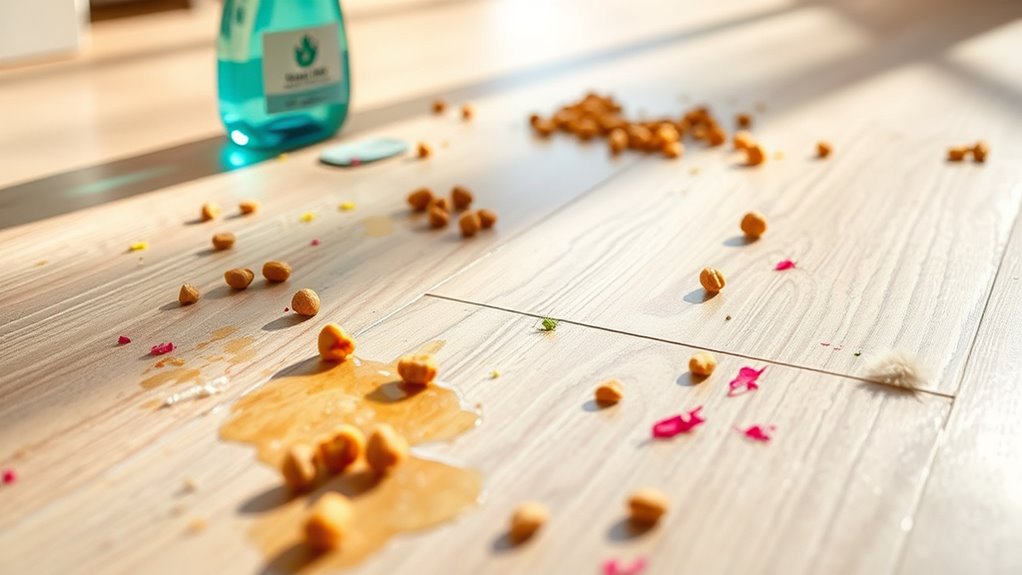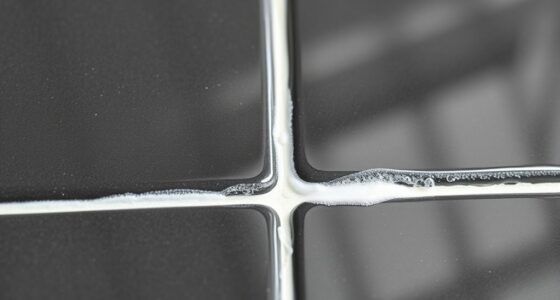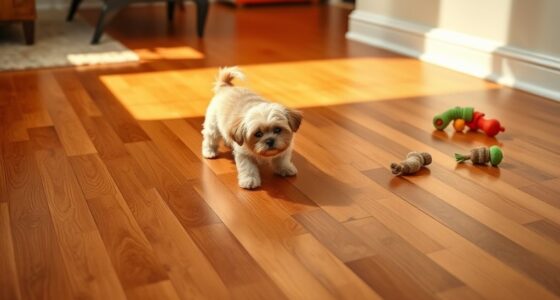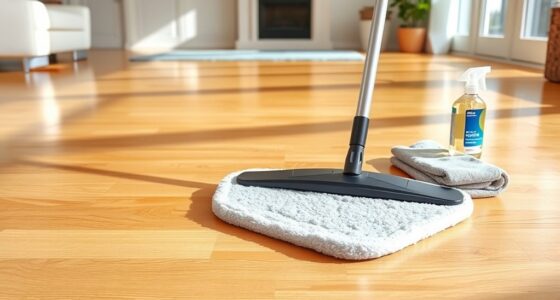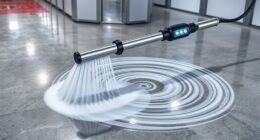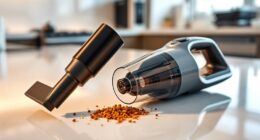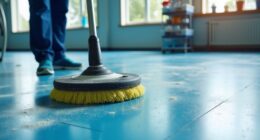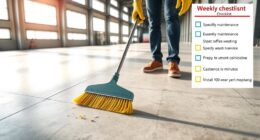When pet messes happen on vinyl plank flooring, act quickly and blot the stain with a clean cloth to prevent it from setting. Use a gentle, pet-safe cleaner like a mixture of dish soap, water, and white vinegar, or a commercial enzymatic solution to neutralize odors. Scrub gently with a soft cloth, rinse thoroughly, and dry completely. Regular use of enzymatic cleaners helps keep your floors fresh. Continue to explore tips for safe, odor-free cleanup to protect your flooring and keep your space smelling fresh.
Key Takeaways
- Act quickly to blot and remove fresh pet messes, preventing stains and odors from setting.
- Use gentle, enzymatic cleaners designed for pet stains to effectively neutralize odors without damaging vinyl.
- Rinse thoroughly with clean water after cleaning to eliminate residues and avoid moisture buildup.
- Test any cleaning solution first on a small, hidden area to ensure safety for vinyl surfaces.
- Dry completely after cleaning to prevent warping, and regularly use enzymatic products for ongoing odor control.
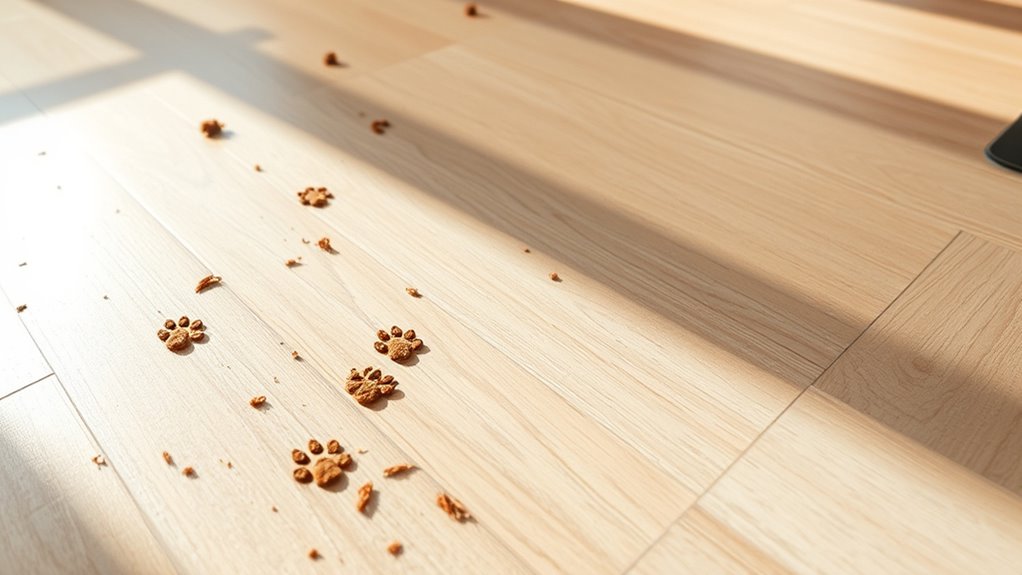
Accidents happen, especially when you have pets, and vinyl plank flooring is no exception. Whether it’s a mischievous puppy, a curious kitten, or an older dog with occasional incontinence issues, spills and messes are part of pet ownership. The good news is that vinyl plank flooring is durable and resistant to moisture, making it easier to clean than many other surfaces. But knowing how to handle pet messes properly is key to keeping your floors looking great and smelling fresh.
When a pet mess occurs, your first step is choosing the right cleaning solutions. You want products that are effective at removing stains and odors but gentle enough not to damage the vinyl. Commercial pet stain removers are designed specifically for this purpose, but you can also opt for homemade solutions. A mixture of mild dish soap, water, and a splash of white vinegar works well for most pet stains. Just remember to test any cleaning solution on a small, inconspicuous area first to guarantee it won’t harm the finish of your vinyl plank flooring.
For pet stain removal, act quickly. The longer a stain sits, the more difficult it becomes to remove and the higher the chance of lingering odors. Blot up any fresh mess with a clean cloth or paper towel—avoid rubbing, as this can spread the stain or push it deeper into the vinyl. Once you’ve blotted up as much as possible, apply your chosen cleaning solution directly to the stain. Let it sit for a few minutes to loosen the debris and break down any odor-causing molecules.
Next, gently scrub the area with a soft-bristled brush or a microfiber cloth. Be cautious not to use abrasive tools that could scratch or damage the surface of your vinyl plank flooring. After scrubbing, rinse the area with clean water and blot dry. It’s important to thoroughly dry the spot afterward to prevent any moisture from seeping into seams or edges, which could cause warping or damage over time.
Odor control is vital in pet stain removal. Once you’ve cleaned up the mess, consider using a pet-safe enzymatic cleaner to eliminate lingering smells. These cleaners break down urine or other organic stains at a molecular level, effectively neutralizing odors and discouraging pets from revisiting the same spot.
Frequently Asked Questions
Can Certain Cleaning Products Damage Vinyl Plank Flooring?
Certain cleaning products can damage vinyl plank flooring, especially those with harsh chemicals or abrasives. You should avoid bleach, ammonia, and solvent-based cleaners, as they can compromise stain resistance and cause discoloration. Instead, use gentle, pH-neutral cleaners for pet odor removal and stain resistance. Proper cleaning maintains your floor’s finish, keeps it looking new, and guarantees pet messes are easily cleaned without risking damage.
How Can I Prevent Pet Messes on Vinyl Plank?
You can prevent pet messes on vinyl plank by mastering pet training and maintaining your flooring diligently. Use consistent commands to keep your pet from accidents, and always keep a close eye, especially during potty training. Place barriers or mats in high-risk areas, and clean spills immediately to deter repeat incidents. Regular flooring maintenance, combined with gentle training, transforms your space into a mess-free haven, making accidents less likely and your floors lasting longer.
Are There Specific Seals or Coatings to Protect Vinyl From Pet Accidents?
Yes, you can protect your vinyl plank with vinyl sealants and protective coatings. These products create a barrier that resists stains and damage from pet accidents, making cleanup easier and preventing odors. Apply a high-quality sealant or coating according to the manufacturer’s instructions, ensuring even coverage. Regular reapplication helps maintain the protection, keeping your floors safe from pet messes and prolonging their lifespan.
What Should I Do if My Pet Ingests Cleaning Residue?
Imagine your pet’s tiny paws stepping cautiously after nibbling on something strange. If you suspect pet ingestion of cleaning residue, act quickly. Call your vet immediately and watch for poisoning symptoms like vomiting, drooling, or lethargy. Do not induce vomiting unless instructed. Prompt professional help is essential, as cleaning residue can be toxic. Your swift response can prevent serious health issues and keep your furry friend safe.
How Often Should I Deep Clean Vinyl Plank Flooring After Pet Accidents?
You should deep clean your vinyl plank flooring after pet accidents weekly or immediately if the stain is fresh. This helps with pet stain removal and keeps odors under control. Regular cleaning prevents buildup and odor lingering, ensuring a fresh, hygienic surface. Use a gentle, pet-safe cleaner and avoid harsh chemicals. Prompt, consistent cleaning is key to maintaining a clean and odor-free environment for your pets and family.
Conclusion
So, when those pet messes hit your vinyl plank, don’t panic or let the chaos take over. With quick, safe cleanup, you can turn disaster into a distant memory faster than you can say “odor-free.” Remember, a little effort now prevents a mountain of trouble later. Your vinyl floor isn’t just a surface—it’s your sanctuary. Keep it spotless, keep it happy, and you’ll outsmart pet messes before they even think about making a comeback!
